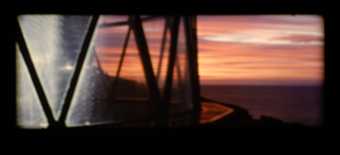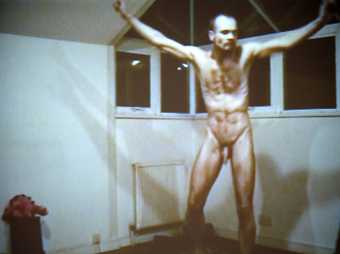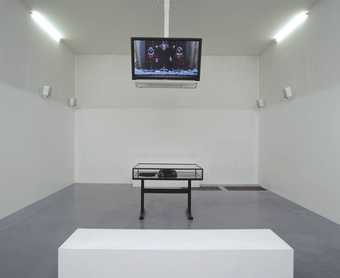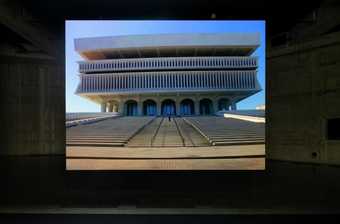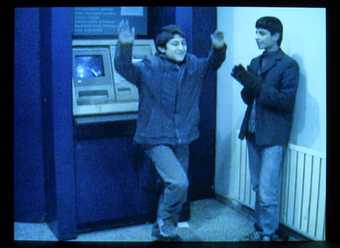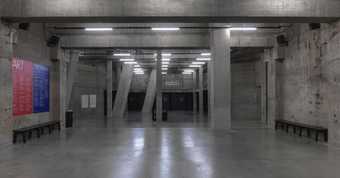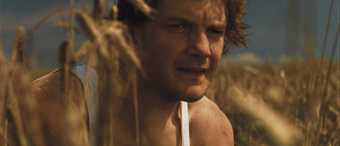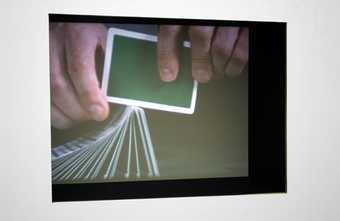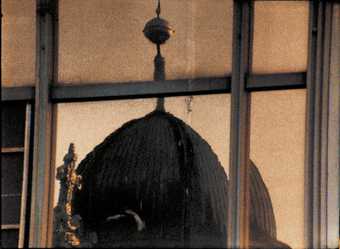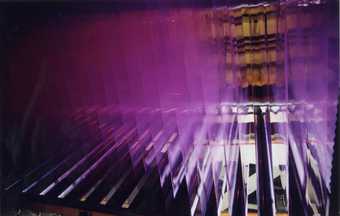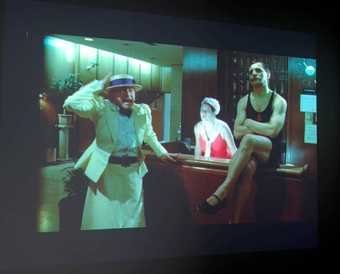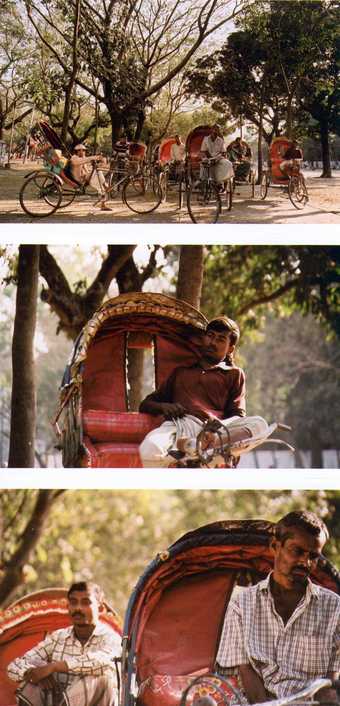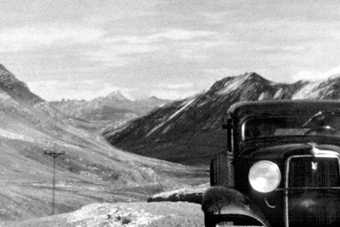
Not on display
- Artist
- Daria Martin born 1973
- Medium
- Film, 16 mm, projection, colour and sound
- Dimensions
- 7min
- Collection
- Tate
- Acquisition
- Purchased 2007
- Reference
- T12744
Summary
In the Palace is the first film in a trilogy followed by Birds
2001 (T12743) and Closeup Gallery 2003 (T12175). It constituted Daria Martin’s MFA thesis at University of California, Los Angeles and was shot with a 16mm camera and released in an edition of four. Tate’s copy is the fourth in the edition. The film is set in a scaled up twenty-five foot (7620 mm) high version of the sculpture The Palace at 4 A.M. 1932 (Museum of Modern Art, New York) by Swiss artist Alberto Giacometti (1901–66), from which it takes its title. Giacometti’s sculpture is a fragile structure made of wood, glass, wire and string, and is open and accessible on all sides. When seen from the front it appears to be divided into three cages, inhabited by isolated forms and figures. Martin first saw Giacometti’s sculpture in her visits to the Museum of Modern Art in New York during her student years, and became attracted to the work’s ‘particularly evocative feeling, as if the figures within it have each been caught within their own dreams, simultaneously sleepwalking through the same house’ (quoted in Daria Martin, p.76). The artist measured the sculpture in MoMA’s archive for the correct proportions, and built the stage herself with the assistance of her art school friends. ‘The idea that sparked In the Palace’ Martin has explained, ‘was a desire to literally realise my own fantasy to inhabit this small sculpture, to blow it up to human dimensions and to populate it with performers’ (quoted in Daria Martin, p.76).
In the film, the camera ceaselessly circles around a group of four performers standing inside this cage-like space, a white painted wooden construction that resembles a scaffold structure. Spotlit against a darkened background, the performers hold sequences of Classical poses that resemble the forms of early twentieth century dance productions, in particular the choreographies of the Ballet Russes from the 1910s and 1920s, the dramatic atmosphere of Lamentation 1930 by American dancer Martha Graham (1894–1991), and most notably, the Slat Dance 1927 conceived by German artist Oskar Schlemmer (1888–1943). Accompanied by a soundtrack of rainfall, thunder and birds singing, each shot shows the transformation of the performers by the introduction of a new set of handmade costumes constructed from diverse materials including cardboard, aluminium paper foil and elastic fabrics, and the addition of props, such as hoops or canes. These sequences of extended shots are edited together and seem to comprise a single relentless circular motion around the performers, only occasionally punctured when they break their poses before the end of each shot.
The trilogy of films beginning with In the Palace arose from the context of Martin’s graduate school training in Los Angeles in the late 1990s, when her peers were turning to mid-twentieth century modernism, examining issues concerned with material specificity and abstract form. ‘I was also attracted to the sense of freedom that this return to “modernism” seemed to promise,’ Martin recalls, ‘but I worried that what many artists were doing wilfully shut out the whole arena of the body and its vulnerability’ (quoted in Daria Martin, p.75). Intrigued by Schlemmer’s direction of the Bauhaus theatre programme from 1923 to 1929, Martin turned for inspiration to ‘some of the stumbling first moments of twentieth century modern culture, when the modernist project hadn’t yet worked out its parameters ... and was open to the contamination of humour, exaggeration, pathos, play, and awkwardness’ (quoted in Daria Martin, p.75). The trilogy pays homage to the Triadic Ballet
1927, Schlemmer’s most impressive attempt to articulate the dancers’ relationship to the space around them, that aimed to re-establish the broken links between the human figure and the industrial environment and to illustrate social harmony. Martin’s trilogy fantasises a relationship between early twentieth century painting, sculpture, fashion and stage and dance production, recalling the modernist idea of total art work or gesamtkunstwerk, while at the same time portraying moments of friction between all the disciplines involved. As the artist has observed, the films dwell ‘on the contradiction of depicting sculpture on film; the camera, circling round constructed sets and static actors, emphasised their materiality and substance, though, paradoxically, the medium’s transparency subtracted that heft’ (quoted in The Uncertain States of America, p.78).
Martin’s films combine sculptural form and painterly colour with the performing body, and are characterised by a lack of dialogue that leaves the body, articulated by pose, as the main means of expression. Martin has always emphasised the artifice, illusion and naturalness involved in the medium of film. Through the deliberate editing and the inclusion of takes filmed after the director’s command to ‘cut’, she draws the viewer’s attention to the handmade nature of the sets, costumes and props, and to the slippage between performance and interaction by the actors who drop their poses, showing a natural smile or looking directly at the camera. Martin has referred to these qualities as ‘low tech-magic’, an approach to creating visual effects that reveals the process of trickery and the intentional artifice that informs her imagined worlds. She has explained:
Film, like art, is artificial, its codes of language invented. In my films, the fakery of their making is foregrounded; shadows appear on backdrops; the actors drop their poses; camerawork is sometimes shaky; narrative is subjugated to a more musical structure. I want to seduce viewers into an imagined space but to allow them ways out of it, seams through which to breathe.
(Quoted in The Uncertain States of America, p.78.)
Further reading:
Daria Martin, exhibition catalogue, Kunsthalle Zürich, 2005.
The Uncertain States of America, exhibition catalogue, Astrup Fearnley Museum of Modern Art, Oslo 2005, p.78.
Rob Bowman, ‘Daria Martin’, Beck’s Futures, exhibition catalogue, Institute of Contemporary Arts, London 2005, pp.65–7.
Carmen Juliá
April 2009
Does this text contain inaccurate information or language that you feel we should improve or change? We would like to hear from you.
Explore
- emotions, concepts and ideas(16,416)
-
- formal qualities(12,454)
-
- photographic(4,673)
- universal concepts(6,387)
-
- artifice(96)
- music and entertainment(2,331)
-
- dance(296)
- tools and machinery(1,287)
-
- wood(81)
- actions: postures and motions(9,111)
-
- arm / arms raised(839)
- stretching(26)
- woman(9,110)
- arts and entertainment(7,210)
-
- dancer(154)
You might like
-
Tacita Dean CBE Disappearance at Sea
1996 -
Sam Taylor-Johnson OBE Brontosaurus
1995 -
Matthew Barney Cremaster 5
1997 -
Shirin Neshat Soliloquy
1999 -
Fikret Atay Rebels of the Dance
2002 -
Trisha Donnelly Untitled
2003 -
Mark Leckey Made in ‘Eaven
2004 -
Jesper Just Bliss and Heaven
2004 -
Daria Martin Closeup Gallery
2003 -
Tacita Dean CBE Palast
2004 -
Tacita Dean CBE Kodak
2006 -
Catherine Sullivan The Chittendens: The Resuscitation of Uplifting
2005 -
Daria Martin Birds
2001 -
Runa Islam First Day of Spring
2005 -
Matthew Buckingham Situation Leading to a Story
1999

